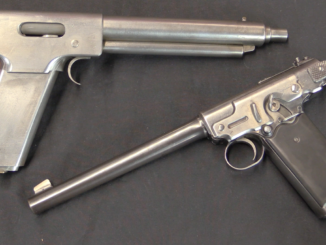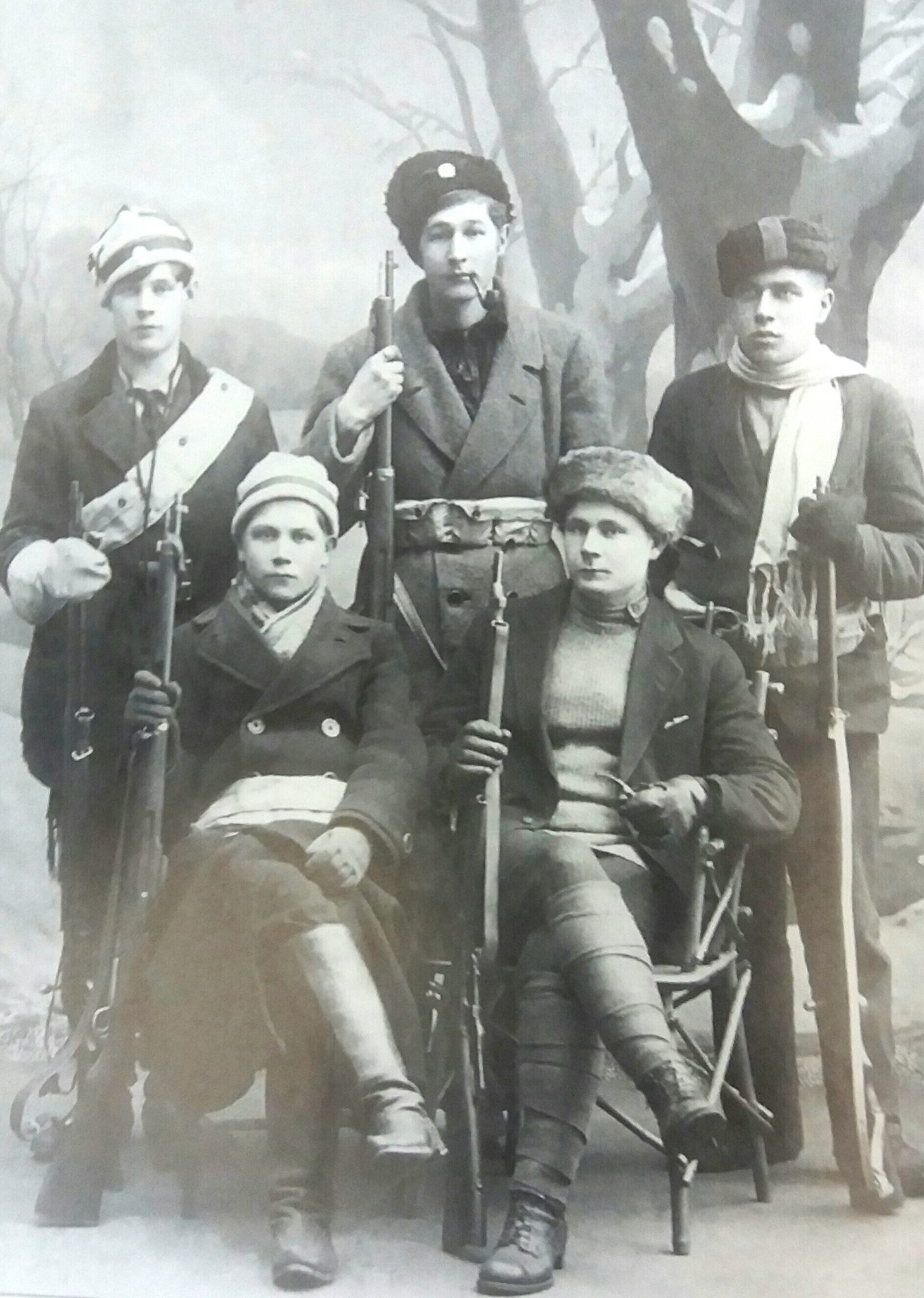One of the domestic American pistols entered in the US 1907 pistol trials was this short recoil, toggle locked design by W.E. Knoble of Tacoma Washington. Knoble submitted two experimental pistols to the trial, one with a single action trigger and one with a double action trigger – although he was unable to attend the trial himself. Unfortunately for Knoble, the trials board found his guns crude and unsatisfactory upon examination, and they were dropped from competition without having fired a single shot. The Luger, Colt/Browning, and Savage would go on the be the winners of the initial trials, with the 1911 ultimately winning.
Knoble’s .45 caliber pistol here does certainly lack the finesse of many other pistols, but it did not appear to me to be dangerously crude, and I am a bit surprised that it was not at least test-fired by the trials board. At any rate, Knoble did make a few other guns of a similar style in .30 Luger and .22 Long Rifle, but never had a design reach a production stage.




This is the US Patent of “Single Action” version; http://www.freepatentsonline.com/0743002.pdf
It seems that this pistol uses usual “Lug and Recess” kind of breechbolt lock getting use of rotational movement of toggle arms to get off the locked mode.
Breechbolt in rest position, the center toggle axis seems far over the joining line of front and rear axis and then, already in broken up position and therefore, a conventional toogle lock can not be happen in that situation. The recoil spring seems of a flat kind located in the back of handle and suffers to provide the sufficient motion ability for the barrel and breechbolt units as expected.
Double action trigger seems natural at that era as borrowed from the largely using revolvers but seems as found unmatching with already cocking hammer through the recoiling breechbolt and left from that time on.
The pistol seems more than enough robust as compared to the Colt 1906 with a violently recoiling back slide against a fragile thin zteel bar and the cause of its dropping off the competition seems questionable. It looks rather crude though.
The related patent text also confirms that this pistol being in no relation with “Toggle Lock” since, far from the term “Toggle Lock”, even the statement “Toggle” takes no place in the specification.
Very interesting! Thanks for sharing.
I think the “window” in the front of the grip was probably just a side effect of making the grip thin enough to get your hand around.
This window seems in some of the patent drawings and might be cut, to feel if the magazine inserted when the gun handled in dark, or to machine the inside of receiver easily. But it would certainly pinch the close finger if the gun grapped and magazine tried to insert. IMHO.
Wonderful that these test pistols survive and pop up every generation or so. We are merely temporary custodians of history, thank you for sharing this. If I had wealth I would feel obligated to bid so I could care for it for a dozen or so years and pass it on.
They didn’t even TRY it??? Sounds like they just didn’t want to deal with an independent designer.
It is quite obvious that this pistol was way on the wrong side of the development curve and a waste of time with so many other pistols submitted much more advanced and the people back then were not stupid. The Luger and Colt 1905 already had significant development history behind them not to mention engineering support. The Savage 1907 was a newbie but clearly well thought out with again, significant engineering and manufacturing support behind it. Although historically quite cool, this pistol was clearly a dead end.
Well, they did try the White-Merrill.
Nicely done as always
Nicely done
I suspect the main reason the Knoble wasn’t tested was the fact that it apparently doesn’t work very smoothly. Note that when Ian released the toggle, the action didn’t return completely to battery. Partly this might be due to “burrs” not worn down yet (today we define 200 rounds as the minimum “break in” for a new self-loader), but also because the design itself has problems in terms of recoil/counter-recoil geometry.
Plus, the feed angle from the magazine is suspect. The DWM Parabellum .45 prototype was noted for feed jams, simply due to the .45 round’s almost perfectly cylindrical profile not being very compatible with the Parabellum’s feed angle, which was of course intended to reliably feed first a bottlenecked and then a tapered conic section cartridge. I’d expect the Knoble to have similar “issues”, probably including the fabled “live round smokestack” stoppage. It’s worth noting that Knoble’s other pistol using this action was in 7.65 x 21mm Parabellum. It probably would have worked better with this sort of feed.
One factor which I think has been overlooked with this pistol is that it may have been in a situation similar to the “Smith & Wesson patent evasions” of 1859-69. The Parabellum toggle system was patented as a variant of the Maxim toggle lock, and DWM had a large and energetic legal department every bit as persistent as Rollin White (if better grounded in legality).
The Knoble may not have been tested due to subtle intimations from DWM that legal action was in the offing. Unlike the Schwarzlose toggle-action pistol Ian showed us recently, this one was essentially s Parabellum action with an outside hammer driving the striker. That may have been sailing too close to the wind on DWM’s patents for the U.S. Army’s JAGO to want to get in the middle of.
cheers
eon
Military is politics by other means
The published literature on guns, almost always assumes a “Whig” philosophy of history and technology, in which there is an inevitable current of upwards and towards the light.
The implicit assumptions are that this is determined independently of humans, that technology somehow advances itself,
The best will always win out
For something to have won, means that it must have been the best available
For something to have been used, it must have been good.
Within that philosophical framework, there is no room for human choices, politics, mistakes…
And no reason to look at Forgotten Weapons, because implicitly, all of the best features are kept and refined in what we have today.
Incidentally, the Marxists also assume a “Whig” philosophy of history, and explicitly state that it is determined by the material productive forces, whatever they might be, because neither Marx nor Engels ever condescended to explain.
______________
I think that we have a fair amount of empirical evidence to back the contra Whig approach. Julian Hatcher, pretty much says that his brother being posted out of the way, so that he couldn’t work on his version of the Bang rifle, which had shown promise in trials, was political, and intended to squash the design.
The arbritary standard of no less energy at 2,000 yards than .30-06 applied to the .280 British, and the substitution of a heavier rifle grenade, without notice, were fairly clear attempts to arbritarily damn the EM2 as “weak”, and propagandists like the Smith’s repeated the smears.
Eugene Stoner, went public with the dirty tricks that he found, being applied during trials of his rifles, like a welding rod being substituted for the cotter pin holding the front sight, so that accuracy could be condemned.
It’s more than likely that there’s a long tradition of backhanders being sought or offered from manufacturers and political deals behind the scenes.
Knoble’s Pistol probably wasn’t up to scratch, but it’s summary dismissal without firing, smacks of wanting it out of the way.